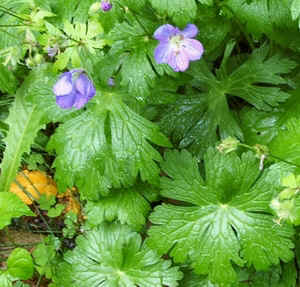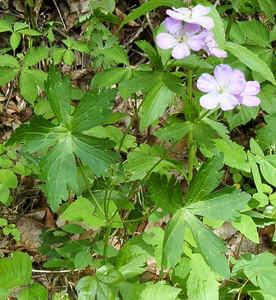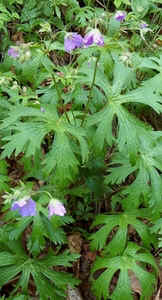 |
 |
 |
Common Name: Wild Geranium, Spotted Cranesbill, Alum-Root
Scientific Name: Geranium maculatum
Family: Geraniaceae
Blue Ridge Parkway
North Carolina
June 1, 2002
 |
 |
 |
This erect, rhizomatous perennial grows to a height of 12 - 24 inches. The largest of the deeply cleft leaves are 2 - 4 inches wide, and the flowers may be 1 inch or more across. Native to the eastern U.S., these plants grow in alluvial woods and in rich coves chiefly in our mountains and piedmont. April - June [Justice, William S. and Bell, C. Ritchie, Wild Flowers of North Carolina. University of North Carolina Press, Chapel Hill, 1968]
The bright pink to purple blossoms of this plant make it easy to identify from a distance. Closer inspection of the five petals reveal fine lines leading toward the reproductive parts. In the 1700s, a botanist first theorized that bees use these to find the flower's nectar. If we could see the same ultraviolet light spectrum that bees do, we would find these "nectar guides" are truly bold markers. To insure cross-pollination, the single pistil matures a day or two after the 10 stamens. A seed capsule develops 3 - 5 weeks later. This beaked fruit gives us the name geranium from the Greek geranos (a crane). The "geranium" of home gardens is in the same plant family but a different genus (Pelargonium). April - May [White, Peter, Wildflowers of the Smokies. Great Smoky Mountains Natural History Association, Gatlinburg, 1996]
Wild geranium, also known as spotted cranesbill, has loose clusters of two to five pink-to-rose-purple, four-petaled flowers, which appear at the tips of smooth branches above a pair of five-lobed leaves. Each flower is 1 to 2 inches across, with five sharply pointed sepals peeking out from behind five rounded petals. The leaves measure up to 5 inches across, are gray-green in color and are cut into three to five deep lobes, with each lobe being deeply toothed. Like other members of the cranesbill family, this plant's fruits are shaped like a crane's bill. Wild geranium was widely used by Indians and early settlers for medicinal purposes. The Indians used the root to cure venereal diseases, and the settlers, who called the plant alum-root because of the astringent taste of the root, used it successfully to cure influenza among children. April - June [Alderman, J. Anthony, Wildflowers of the Blue Ridge Parkway. The University of North Carolina Press, Chapel Hill, 1997]
Because wild geranium cannot self-pollinate and is entirely dependent on insects for pollination, it makes a good candidate for studying the interaction of insects with plants. Look closely at the flower petals. You will see light-colored lines that run from the outer edge of the petal toward the center of the flower. These are thought to guide insects to the nectar. After pollination, the pistil becomes long and thin as it develops into a fruit resembling a bird's beak, thus the common name cranesbill. Used in a poultice, the tannin-rich roots act as a coagulant to help stop bleeding. Diarrhea, hemorrhoids, gum diseases, and stomach disorders are among the many ailments that have been treated with the plant. At one time geranium was listed in the United States Pharmacopoeia. April - June [Adams, Kevin and Casstevens, Marty, Wildflowers of the Southern Appalachians: How to Photograph and Identify Them. John F. Blair, Publisher, Winston-Salem, 1996]
January February March April May June July August September October November December
Alphabetical Listings -- A B C D, E F G H I, J, K L M N, O P Q, R S T U, V W X, Y, Z
Family Listings -- A B C D, E F G H I, J, K L M N, O P Q, R S T U, V W X, Y, Z
Genus Listings -- A B C D, E F G H I, J, K L M N, O P Q, R S T U, V W X, Y, Z